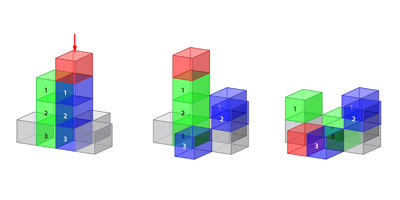August 19, 2013 report
Researchers develop model to help control cascading events

(Phys.org) —A team of researchers at the University of California has developed a model that might lead to a better way to control natural cascading events such as landslides, earthquakes, or even neural networks. In their paper published in the journal Physical Review Letters, the team describes how they expanded on prior research using simulated sand piles to develop statistical models for controlling complex cascading events.
Examples of taking small actions to prevent a large catastrophe are numerous—workers at ski resorts commonly use dynamite to cause small landslides in the hopes of avoiding larger ones, is just one example. The problem with such efforts is that there is no scientific or mathematical basis for such actions. How do ski operators know that they are reducing risk; worse, how do they know that they're not making things worse? Sadly, the current model is to use past experience, hunches, and sometimes prayer. In this new effort, the research team sought to create a computer model that could help control a complex system in a reproducible way. It's all based on what's known as the theory of self-organized criticality (SOC).
The team began by reproducing the efforts of prior researchers where simulated grains of sand were used to create simulated mounds, along with simulated avalanches when critical points were reached. To better simulate the real world, the researchers created several mounds, all close enough to one another to be impacted by the others should they crumble. In so doing, the researchers studied the most important sand grain of all—the one that causes a mound to topple. Prior research had shown that the mounds organized themselves into critical states that could be described by power-law avalanche size distribution, which is what SOC describes. In this new model, the researchers assigned a variable to the probability of a given mound cascading if one more grain were added to it, then sought to control that variable. They found that by increasing or decreasing its value, cascades could be both initiated and avoided. By running the model with different values, the team found they were better able to study the dynamics of the entire system.
The most interesting result they found was that sometimes if they tried too hard to suppress large avalanches by causing smaller ones, they were inadvertently increasing the chances of a large one happening anyway.
While the researchers' model is interesting, there is no clear evidence that suggests real-world events transpire as clearly as can be defined by a computer simulation. For that reason, much more work will have to be done before it's known whether the new model might be used to help control real-world systems.
More information: Controlling Self-Organizing Dynamics on Networks Using Models that Self-Organize, Phys. Rev. Lett. 111, 078701 (2013)
Abstract
Controlling self-organizing systems is challenging because the system responds to the controller. Here, we develop a model that captures the essential self-organizing mechanisms of Bak-Tang-Wiesenfeld (BTW) sandpiles on networks, a self-organized critical (SOC) system. This model enables studying a simple control scheme that determines the frequency of cascades and that shapes systemic risk. We show that optimal strategies exist for generic cost functions and that controlling a subcritical system may drive it to criticality. This approach could enable controlling other self-organizing systems.
Journal information: Physical Review Letters
© 2013 Phys.org



















